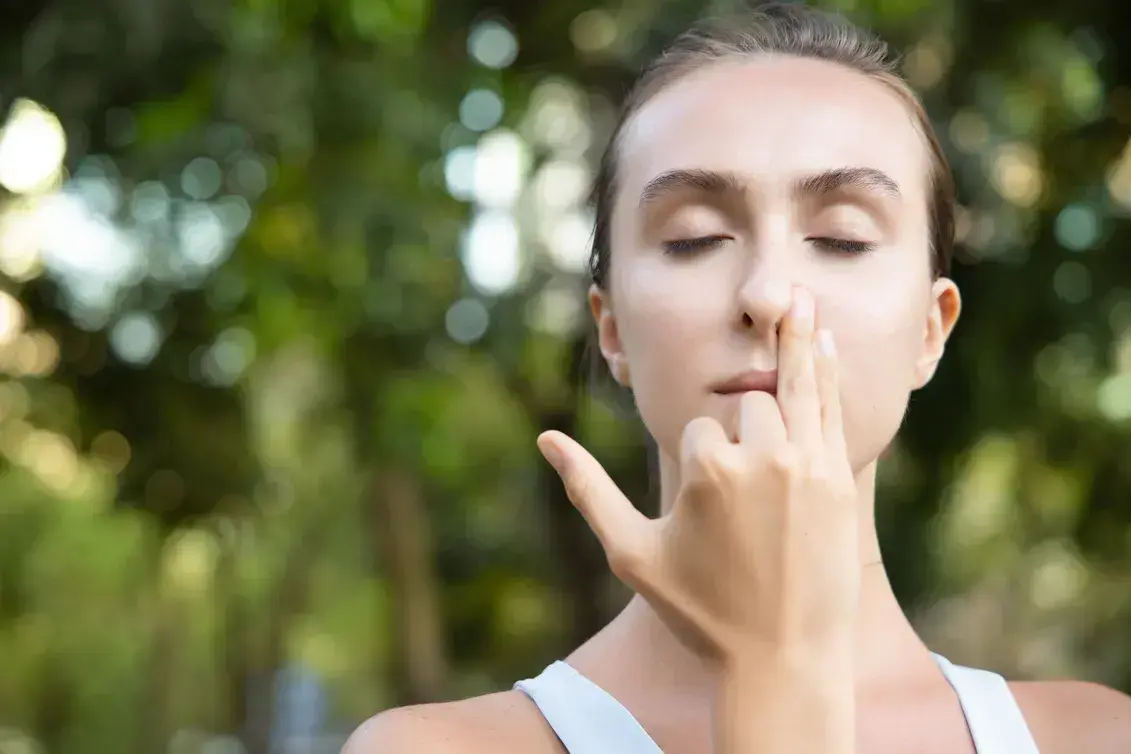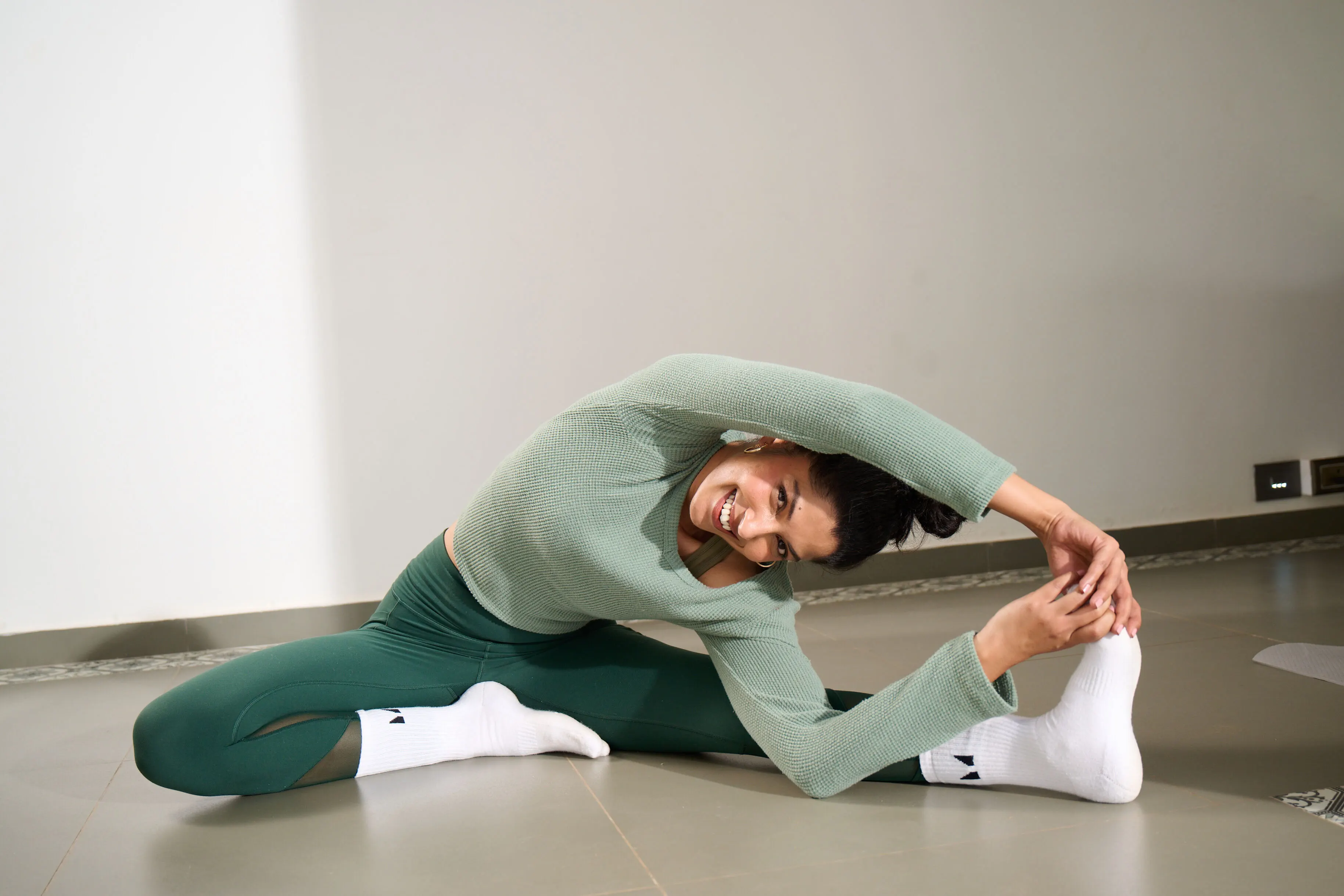What is the Swaying Palm Tree Pose?
Known as Tiryak Tadasana in Sanskrit, the Swaying Palm Tree Pose is a standing posture that mimics the gentle swaying of a palm tree in the wind. This pose involves standing tall with feet hip-width apart, arms extended overhead, and then bending sideways at the waist to stretch the entire side body. It is an effective pose for improving flexibility in the spine, strengthening the core, and releasing tension in the shoulders and back. The rhythmic swaying motion promotes balance, enhances coordination, and brings a sense of calmness, making it a beneficial addition to any yoga practice.
Position type: Standing
Posture type: Lateral bend
Ideal for: Flexibility
Targets: Back, shoulder, thorax
Pose level: Beginner
How to prepare for the Swaying Palm Tree Pose?
The Swaying Palm Tree Pose itself is a beginner-friendly posture that prepares you for other asanas. However, you can practice the following to improve the practice of Tiryak Tadasana.
- Spinal flexibility: To fully benefit from the Swaying Palm Tree Pose, enhancing spinal flexibility is key. Engage in regular practice of poses like Cat-Cow Pose (Marjariasana) to mobilize the spine and improve flexibility. Incorporate gentle backbends such as Cobra Pose (Bhujangasana) and Bridge Pose (Setu Bandhasana) to increase spinal extension. Forward folds like Standing Forward Bend (Uttanasana) will help in stretching and lengthening the spine, preparing it for the swaying motion.
- Core strength: Strengthening the core is essential for stability in this pose. Work on core-focused poses like Plank Pose (Phalakasana), Boat Pose (Navasana), and Low Plank (Chaturanga Dandasana). These poses will build the necessary strength in your abdominal muscles to support the side bends and maintain balance during the sway.
- Shoulder mobility: Improving shoulder mobility will enhance the stretch in the Swaying Palm Tree Pose. Practice shoulder openers like Cow Face Pose (Gomukhasana) arms, Thread the Needle Pose, and Shoulder Circles. These movements will help you achieve a greater range of motion in your shoulders, allowing for a deeper stretch in the pose.
- Side body stretches: Since the pose emphasizes lateral stretching, incorporate side body stretches into your practice. Begin with gentle stretches like the Seated Side Bend (Parsva Sukhasana) and Gate Pose (Parighasana). Gradually progress to more intense side stretches like Triangle Pose (Trikonasana) and Extended Side Angle Pose (Utthita Parsvakonasana) to prepare the side body for a fuller stretch.
How to do Swaying Palm Tree Pose Getting into the posture:
- Stand with your feet hip-width apart and arms relaxed at your sides. Distribute your weight evenly on both feet, grounding through the soles.
- Lengthen your spine by gently engaging your core and lifting through the crown of your head.
- Inhale deeply, and as you exhale, slowly raise both arms overhead.
- Interlace your fingers with palms facing upward, or keep your palms parallel to each other. Ensure your shoulders are relaxed and away from your ears.
- Activate your core muscles to maintain stability. Keep your spine straight and avoid arching your lower back.
- Inhale deeply, and as you exhale, gently bend your upper body to the right. Keep both feet firmly on the ground and avoid leaning forward or backward. Feel the stretch along the left side of your body, from your fingertips down to your hip.
- Inhale as you return to the center, lengthening your spine.
- Exhale and repeat the bend to the left, stretching the right side of your body.
- Continue this swaying motion, moving slowly and mindfully with each breath.
- Aim for 5-10 sways on each side, ensuring a smooth and gentle flow.
Getting out of the posture:
- Return to the center with both arms overhead. Exhale and slowly lower your arms to your sides.
- Take a few moments to observe the effects of the pose, feeling the release of tension in your body.
- Stand still in Mountain Pose (Tadasana) for a few breaths, allowing your body to settle.
Key Alignments:
- Spine Alignment: Keep your spine elongated and neutral throughout the pose. As you sway from side to side, avoid arching your lower back or collapsing your chest. Maintain a straight line from the crown of your head down to your tailbone, engaging your core to support the spine and prevent any strain.
- Foot Placement and Stability: Ensure that your feet are firmly grounded and parallel to each other, hip-width apart. Distribute your weight evenly across both feet, pressing into the outer edges to maintain balance. This grounding helps stabilize the lower body, allowing for a smoother and more controlled side bend without compromising your alignment.
What are the benefits of Swaying Palm Tree Pose?
Tiryak Tadasana effectively stretches the entire side body, including the obliques, intercostal muscles, and shoulders, promoting flexibility and relieving tension in these areas. By engaging the core muscles, it helps to improve balance and stability, which are crucial for overall body alignment. The gentle swaying motion encourages a mindful connection between breath and movement, encouraging relaxation and reducing stress. Additionally, Tiryak Tadasana aids in improving posture by lengthening the spine and opening the chest, making it an excellent preparatory pose for more advanced asanas. Regular practice of this pose can contribute to better circulation, enhanced body awareness, and a greater sense of calm and centeredness.
What are the contraindications of Swaying Palm Tree Pose? While Tiryak Tadasana is generally a gentle pose, there are some contraindications to consider. Individuals with lower back pain or spinal injuries should practice this pose with caution or avoid it altogether, as the side bending motion may exacerbate these conditions. Those with shoulder or neck issues should be mindful of arm positioning to avoid straining these areas. Anyone with high blood pressure or vertigo should proceed carefully, as the pose's swaying motion might cause dizziness or discomfort. It's always advisable to consult a healthcare professional or experienced yoga instructor before attempting this pose if you have any of these conditions.
Counterposes of Tiryak Tadasana
Stand in Tadasana for a minute or practice Adho Mukha Svanasana (Downward-facing Dog Pose) for a minute after doing Tiryak Tadasana.
Variations of Tiryak Tadasana
- Hands on Hips: If extending the arms overhead feels too intense or causes strain in the shoulders or neck, you can modify the pose by placing your hands on your hips. This variation still allows for the side bending motion, focusing on the stretch in the side body while reducing pressure on the upper body.
- Chair-Assisted Tiryak Tadasana: For those with limited balance or mobility, performing this pose while seated in a chair is an effective modification. Sit with your feet flat on the floor, hip-width apart, and gently bend sideways, placing one hand on the side of the chair for support. This variation provides stability and is especially useful for seniors or those recovering from injuries.
- One Arm Variation: Instead of raising both arms overhead, you can keep one arm down by your side while the other extends overhead. This variation reduces the intensity of the stretch and can be helpful for beginners or individuals with shoulder or neck issues. It allows for a more gradual opening of the side body while maintaining stability.
Advice for Beginners
Focus on maintaining a smooth and steady breath as you move, which helps in coordinating the sway and avoiding strain. Start with smaller side bends to gradually build flexibility, and keep your movements gentle to prevent overstretching. Ensure your feet are firmly grounded and engage your core to support your spine throughout the pose. Remember, it’s more important to prioritize correct alignment over depth in the pose.
Shvasa Tips:
- Synchronize your breath with each sway to maintain a steady and controlled movement. Inhale deeply as you lengthen your spine, and exhale as you bend to each side, which helps deepen the stretch and enhance relaxation.
- Activate your core muscles to support your lower back and maintain stability throughout the pose.
- Move slowly and deliberately, paying attention to how your body feels in each position. This mindful approach will improve your body awareness and prevent unnecessary strain.
Learn how to practice the Tiryak Tadasana LIVE on Shvasa.
Meta Description: Learn how to practice Tiryak Tadasana live on Shvasa. Benefits, precautions, modifications and practice tips for Tiryak Tadasana.
Summary: Tiryak Tadasana is an effective pose for improving flexibility in the spine, strengthening the core, and releasing tension in the shoulders and back
FAQs:
- What is the Swaying Palm Tree Pose?
Known as Tiryak Tadasana in Sanskrit, the Swaying Palm Tree Pose is a standing posture that mimics the gentle swaying of a palm tree in the wind. It is an effective pose for improving flexibility in the spine, strengthening the core, and releasing tension in the shoulders and back. The rhythmic swaying motion promotes balance, enhances coordination, and brings a sense of calmness, making it a beneficial addition to any yoga practice.
- What are the benefits of Swaying Palm Tree Pose?
Tiryak Tadasana effectively stretches the entire side body, including the obliques, intercostal muscles, and shoulders, promoting flexibility and relieving tension in these areas. By engaging the core muscles, it helps to improve balance and stability, which are crucial for overall body alignment. The gentle swaying motion encourages a mindful connection between breath and movement, encouraging relaxation and reducing stress.
- What are the contraindications of Swaying Palm Tree Pose?
While Tiryak Tadasana is generally a gentle pose, there are some contraindications to consider. Individuals with lower back pain or spinal injuries should practice this pose with caution or avoid it altogether, as the side bending motion may exacerbate these conditions. Those with shoulder or neck issues should be mindful of arm positioning to avoid straining these areas.
- How to do Swaying Palm Tree Pose
- Stand with your feet hip-width apart and arms relaxed at your sides. Distribute your weight evenly on both feet, grounding through the soles.
- Lengthen your spine by gently engaging your core and lifting through the crown of your head.
- Inhale deeply, and as you exhale, slowly raise both arms overhead.
- Interlace your fingers with palms facing upward, or keep your palms parallel to each other. Ensure your shoulders are relaxed and away from your ears.
- Activate your core muscles to maintain stability. Keep your spine straight and avoid arching your lower back.
- Inhale deeply, and as you exhale, gently bend your upper body to the right. Keep both feet firmly on the ground and avoid leaning forward or backward. Feel the stretch along the left side of your body, from your fingertips down to your hip.
- Inhale as you return to the center, lengthening your spine.
- Exhale and repeat the bend to the left, stretching the right side of your body.
- Continue this swaying motion, moving slowly and mindfully with each breath.
- Aim for 5-10 sways on each side, ensuring a smooth and gentle flow.
- Return to the center with both arms overhead. Exhale and slowly lower your arms to your sides.
- Take a few moments to observe the effects of the pose, feeling the release of tension in your body.
- Stand still in Mountain Pose (Tadasana) for a few breaths, allowing your body to settle.














.jpg)












%201.png)

%201.svg)






%201.svg)